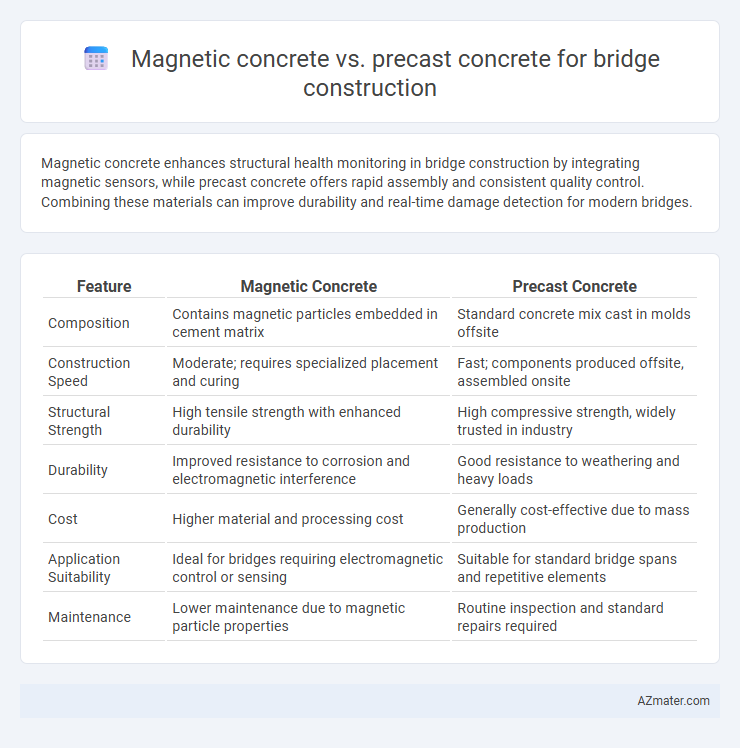Magnetic concrete enhances structural health monitoring in bridge construction by integrating magnetic sensors, while precast concrete offers rapid assembly and consistent quality control. Combining these materials can improve durability and real-time damage detection for modern bridges.
Table of Comparison
| Feature | Magnetic Concrete | Precast Concrete |
|---|---|---|
| Composition | Contains magnetic particles embedded in cement matrix | Standard concrete mix cast in molds offsite |
| Construction Speed | Moderate; requires specialized placement and curing | Fast; components produced offsite, assembled onsite |
| Structural Strength | High tensile strength with enhanced durability | High compressive strength, widely trusted in industry |
| Durability | Improved resistance to corrosion and electromagnetic interference | Good resistance to weathering and heavy loads |
| Cost | Higher material and processing cost | Generally cost-effective due to mass production |
| Application Suitability | Ideal for bridges requiring electromagnetic control or sensing | Suitable for standard bridge spans and repetitive elements |
| Maintenance | Lower maintenance due to magnetic particle properties | Routine inspection and standard repairs required |
Introduction to Magnetic Concrete and Precast Concrete
Magnetic concrete incorporates ferromagnetic materials that enhance structural health monitoring through electromagnetic sensing, offering real-time damage detection in bridge construction. Precast concrete involves casting concrete elements in controlled factory environments, enabling high quality and faster erection on-site for bridge components such as beams, decks, and piers. Both materials address durability and construction efficiency, with magnetic concrete providing advanced monitoring capabilities and precast concrete optimizing fabrication and assembly processes.
Key Material Properties Comparison
Magnetic concrete incorporates ferromagnetic particles, enhancing its electromagnetic properties and enabling structural health monitoring, unlike conventional precast concrete which offers superior uniformity and controlled curing due to factory production. Precast concrete exhibits higher compressive strength and durability, typically ranging from 30 to 60 MPa, whereas magnetic concrete's mechanical properties depend on the concentration of magnetic additives, often resulting in slightly reduced strength. The thermal and magnetic conductivity of magnetic concrete allows for advanced sensing capabilities in bridge applications, whereas precast concrete excels in consistent quality and rapid on-site assembly.
Structural Performance in Bridge Applications
Magnetic concrete incorporates magnetic particles to enhance load distribution and vibration damping, resulting in improved structural performance under dynamic bridge loads compared to traditional precast concrete. Precast concrete offers high uniformity, rapid installation, and proven durability but may exhibit limitations in adaptive stress absorption during seismic or heavy traffic conditions. Magnetic concrete's ability to modify magnetic field-induced stresses provides innovative resilience, potentially extending bridge lifespan and reducing maintenance costs in critical infrastructure applications.
Installation and Construction Speed
Magnetic concrete offers accelerated installation through its enhanced curing process and magnetic particle alignment, significantly reducing setting time compared to traditional methods. Precast concrete enables rapid assembly with factory-controlled quality and minimized on-site labor, allowing for quicker placement of structural elements. While magnetic concrete facilitates faster in-situ curing, precast concrete excels in overall project speed due to off-site manufacturing and streamlined on-site installation.
Durability and Longevity Considerations
Magnetic concrete incorporates ferromagnetic materials enhancing self-sensing capabilities but may face durability challenges due to potential corrosion of magnetic particles in harsh environments, affecting longevity. Precast concrete offers superior durability with controlled manufacturing conditions reducing micro-cracks and improving resistance to freeze-thaw cycles, chloride penetration, and chemical attacks, thereby extending the service life of bridges. Longevity in bridge construction is optimized with precast concrete through uniform quality and accelerated curing processes, ensuring consistent strength and durability over time.
Cost Analysis: Magnetic vs Precast Concrete
Magnetic concrete offers potential long-term cost savings in bridge construction due to reduced maintenance and enhanced durability from embedded magnetic materials that detect structural integrity issues early. Precast concrete typically involves higher upfront manufacturing and transportation costs but benefits from faster on-site assembly, lowering labor expenses and minimizing construction time. Cost analysis reveals magnetic concrete's initial material investment is higher, but lifecycle savings in upkeep and monitoring can offset the precast concrete advantages, making magnetic concrete a competitive choice for sustainable infrastructure projects.
Sustainability and Environmental Impact
Magnetic concrete incorporates ferromagnetic materials that enhance structural health monitoring, reducing maintenance needs and extending bridge lifespan, thereby lowering environmental impact. Precast concrete offers controlled factory production, minimizing waste and carbon emissions through efficient resource use and reduced on-site construction time. Both materials contribute to sustainable bridge construction by optimizing durability and reducing carbon footprints, with magnetic concrete advancing smart infrastructure capabilities.
Maintenance Requirements for Each Method
Magnetic concrete for bridge construction demands lower maintenance due to its enhanced self-sensing capabilities, enabling real-time structural health monitoring and early detection of cracks or deformations. Precast concrete requires regular inspection and joint maintenance to address potential issues like joint leakage and initial curing inconsistencies. The integration of magnetic particles in magnetic concrete significantly reduces long-term repair costs by facilitating proactive maintenance strategies.
Case Studies: Real-World Bridge Projects
Case studies comparing magnetic concrete and precast concrete in bridge construction reveal distinct advantages in durability and installation efficiency. The Guangzhou Magnetic Bridge project demonstrated magnetic concrete's enhanced structural health monitoring capabilities through embedded sensors, while the Millau Viaduct in France highlighted precast concrete's rapid assembly and cost-effectiveness in long-span bridge construction. Data from these projects indicate magnetic concrete's potential for smart infrastructure applications, whereas precast concrete remains the preferred choice for large-scale, time-sensitive projects.
Future Trends and Innovations in Concrete Bridge Construction
Emerging trends in bridge construction emphasize integrating magnetic concrete for its self-sensing capabilities, enabling real-time structural health monitoring and proactive maintenance. Precast concrete continues to evolve with innovations in modular design and high-performance materials that accelerate construction timelines and enhance durability. Combining smart magnetic concrete technology with precast elements is anticipated to revolutionize bridge safety and longevity in future infrastructure projects.

Infographic: Magnetic concrete vs Precast concrete for Bridge construction
 azmater.com
azmater.com